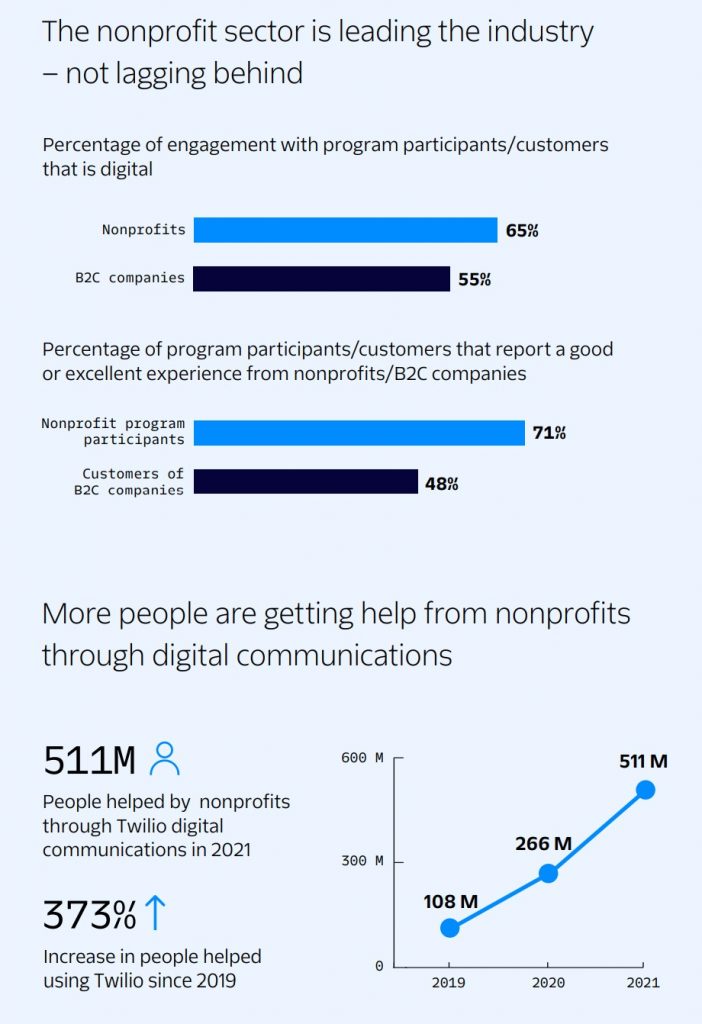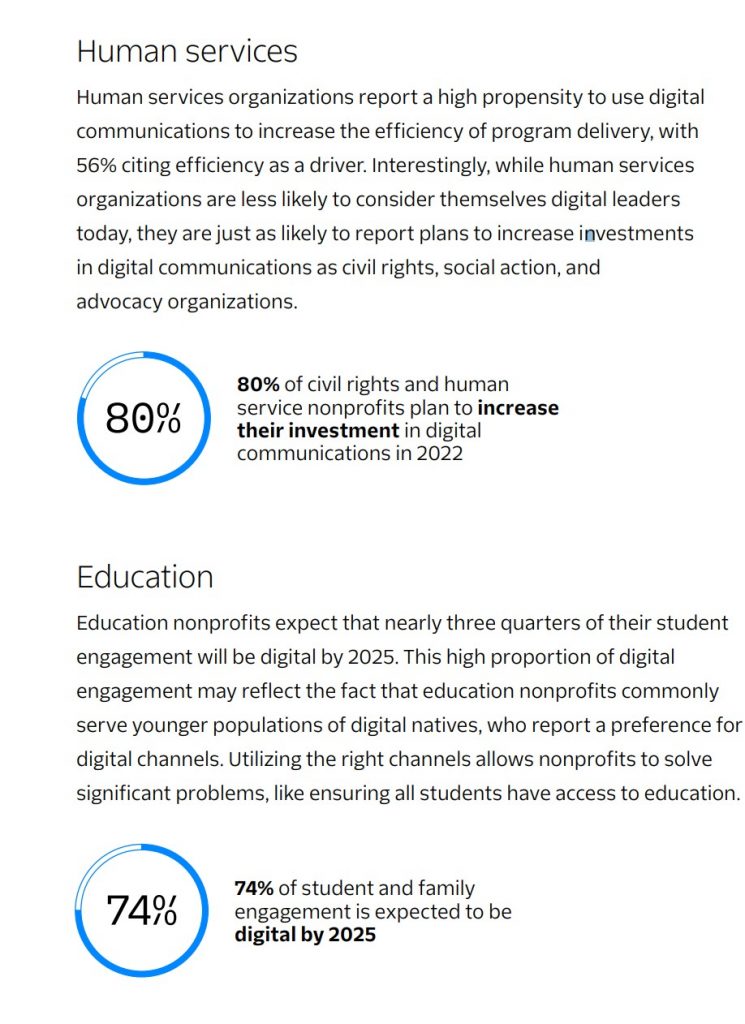A recent Twilio report highlights how far ahead of the curve charities are in the race to adopt digital engagement tools. According to the report, 65% of charitable engagement with stakeholders is digital.
Compare this to a mere 55% of digital interactions (that occur) between businesses in the private sector. An additional 89% of non-profits report digital communications being "critical" to achieving operational goals. These tools, therefore, have started to reshape how digital engagement occurs in the non-profit world and how they deliver critical services.
Twilio's State of Nonprofit Digital Engagement Report reflects data from the Twilio CPaaS platform; and the attitudes of the 800 employees of non-profit organizations surveyed, accompanied by 1,500 non-profit participants based in the United Kingdom and the United States.

Covering the enterprise technology beat as a reporter, I primarily write about unified communications and collaboration (UCC). I also tend to focus most of my time discussing enterprise applications. And on businesses of all sizes, for that matter.
Yet this report is much different - and will focus on the world of non-profits: which holds a lot of weight: and the folks here often leverage the same tools that large enterprises use to communicate, both internally and externally.
Below, I will dive deeper into the findings of the survey: which might surprise some, although after combing through it with a fine-toothed comb: I understand how much significance the survey discoveries hold in terms of significance, and I'm not surprised. Here is what Twilio found.
Non-Profits See ROI After Digital Tool Adoption
Charitable organizations, much like enterprises, play a critical role in addressing some of the world’s most sizable challenges. This includes solving everything from humanitarian crises to displacement from war, education, and even inequality to healthcare access.
According to Twilio, an astonishing 89% of non-profit organizations reported digital communications being "critical" to achieving their organization’s mission. "Nonprofits also outpace the private sector when it comes to digital engagement, reporting that 65% of their engagement with program beneficiaries is digital, compared to 55% of digital engagement among B2C companies," Twilio wrote in the report.
Erin Reilly, Chief Social Impact Officer, Twilio told GetVoIP News:
“As the frequency and severity of crises continue worldwide, digital engagement remains vital to help people access the resources they need to thrive. Non-profits are some of the most technically innovative organizations, and this research highlights the digital strategies they have embraced to deepen impact and improve program outcomes.”
Furthermore, Twilio research reflects that non-profits view digital communications as a critical long-term platform for helping stakeholders address issues faster than other tools. Twilio found that, on average, organizations experience 3.6 principal benefits to their core programs when they digitize program participant engagement.
"Yet there’s still an opportunity to leverage digital communication to engage participants more effectively."
Seventy percent of participants told Twillo that digital communications remain central in helping discover services: while 45% of charities reported using digital communications to increase the visibility of their programs and services.
Talent Access Remains Ongoing Barrier
Also, according to Twilio's survey, access to developer talent remains one of the most sizable barriers to their efforts in accelerating digital transformation.
Twilio found that gaining access to software developers remains critical to building new non-profit engagement experiences. And adding new channels and capabilities respondents said will "ultimately drive deeper impact." Forty-one percent of nonprofits said that a lack of technical support takes the number one spot when considering the adoption of digital communications.
Only one-in-four nonprofits "at the beginning stages of digital maturity" reported having the developer talent they need, making accessing developers a top obstacle to digital adoption. Charity leaders said they require the additional technical capacity to build high-impact digital programs, with Twilio noting:
"Encouragingly, 65% of organizations plan to hire developers in 2022, and that number jumps to 89% among organizations further along in their adoption of digital."
Personalized DX: a Noteworthy Area
Highlighting differing communications preferences across industries and generations, Twilio furthermore; found that the trends outline how non-profits communicate across audiences.
These organizations wish to (more effectively) achieve organizational goals and serve more stakeholders. According to the survey findings, 'elder' generations (are said to) prefer well-established channels like email, text, and phone calls. Younger generations noted that they are more likely to leverage emerging channels like messaging apps, video conferencing, and webchat like the ones Twilio develops.

Among education-based organizations, 74% of student and family-based engagement will likely get digitized by (the year) 2025. Finally, health-related charities said they are more likely to leverage digital communications to increase things like patient response time. They also hope to use said tools to "innovate service delivery."
What's Next?: Charities say: Increased Investing
What is clear; is that digital channels, accompanied by traditional channels like email, remain central to delivering critical services offered by charities in the U.S. and U.K. The report merely sheds light on the efforts in the industry to combat the numerous challenges facing these organizations.
An overwhelming amount of non-profit leaders say they have seen the benefits of digitizing their program offerings. They further note that they plan to continue to invest in building out their technical teams (along with) advanced data-driven capabilities.
"As they do so, they will continue to improve services for participants and make progress towards fulfilling their mission. While (the majority) of non-profits believe that digital communications are critical to achieving their mission, only half report that their current digital communications strategy is effective."
Respondents to the survey told Twilio that ongoing investment should allow organizations to innovate further to meet more participants and that it is a must. Making communications more personalized, easy to adapt to local languages, and able to extend more channels to meet diverse stakeholder demands are of a high priority.

Non-profits, therefore, appear to be some of the most forward-thinking beneficiaries of digital tools, seemingly even more so than enterprises and SMBs (small-to-medium-sized businesses); in many ways.
Increasing investment in this principal area should only help to push these organizations far ahead of the curve in adopting digital tools that help them get out things like messages and updates in ways that might otherwise prove challenging to pull off.
Stay tuned for the latest UCC headlines and more on GetVoIP News.




